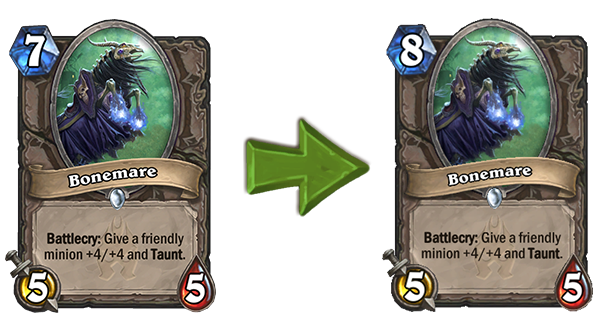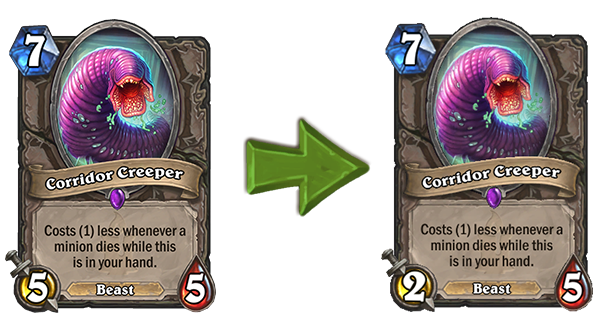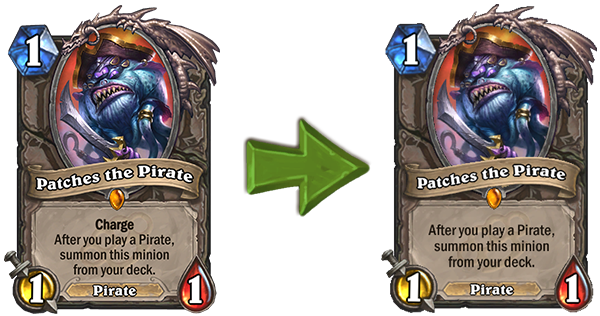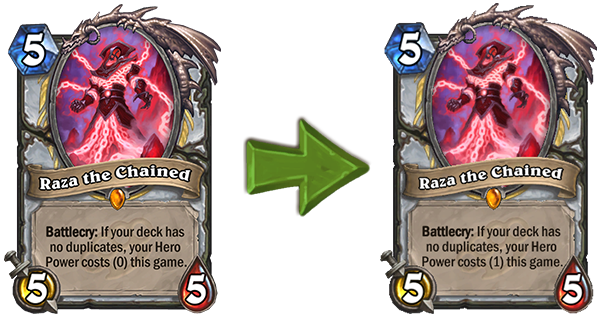The Year of the Mammoth is coming to a close and with it, card set rotations. On Tuesday, Blizzard announced nerfs to four key cards they believed were making the metagame stagnant and so it’s time to break down exactly what those changes are and what they could mean for your decks.
For those unaware, Hearthstone separates its card sets into two categories – standard format and wild format.
Standard format includes the basic card set, the classic card set and expansions less than two years old, while cards from expansions that have been around for more than two years get moved into the non-competitive wild format, alongside ‘Hall of Fame’ cards that simply proved too powerful to rework.
Blizzard does this to keep Hearthstone accessible to newcomers – otherwise anyone new to the game would have well over 1,000 different cards to learn and strategise with. They also do this to stop the overall power level of certain combos reaching astronomical levels, while also allowing newer playstyles and deck archetypes as older ones get put out to pasture.
This April, we’re likely to get 2018’s first new expansion, which will see 2016’s three card sets – Whispers of the Old Gods, One Night in Karazhan and Mean Streets of Gadgetzan – relegated to wild. But before that – as in, the first half of this month – four cards will see changes that will hopefully see them lose their auto-include status for just about every deck.
Bonemare – Increased mana cost

Ah, the good old Bonemare. The heavily discounted combo of a Devilsaur’s stats and Blessing of Kings (WITH Taunt) for a mere seven mana has been one of the most complained about cards since it was introduced in August as part of the Knights of the Frozen Throne expansion. In its current form, Bonemare basically sets a deadline for any aggressive deck to have the job done before turn seven – or turn six with the coin – because once the card drops, even the cheapest of minions is, all of a sudden, a reasonable threat.
Every player at the Championship in Amsterdam put the Bonemare in their Rogue deck, with its ability to swing tempo and a potential nasty combination with Shadowstep making it too good to pass up.
Now, however, the card is having its cost upped to eight mana, but what change will that have on its viability?
If you ask me, not a great deal.
The Bonemare will still present great value for anyone looking to punish an aggressive push and, although players will now have an extra turn to build the board they want before having to worry about getting tripped up by a 6/5 Southsea Deckhand, this card will still see a lot of play.
Corridor Creeper – Attack decreased

This card is the closest thing we have to a definition of ‘auto-include’ right now. At the recent World Championship, Corridor Creeper featured in 27 of the 64 total decks brought to the tournament, with all but two of the 16 competitors utilising the card at least once.
That level of prominence is unprecedented – especially across classes – at such an event, although the card’s unique text does make it an undeniably powerful weapon.
It doesn’t reduce in cost for the next turn only, and it doesn’t only reduce in cost when one of your minion dies, its cost is reduced permanently whenever any minion dies. This leads to absurd power surges in the early turns, with a 5/5 minion arriving as early as turn three.
It can also form an outrageous combo with the aforementioned Bonemare, with a player potentially going from an empty board to a 5/5 and a 9/9 with Taunt for just seven mana.
Fan outrage with this card’s ability to turn matches on their head has led to its attack being whittled all the way down to just 2.
Some have suggested this is a ‘nuke nerf’ and that Corridor Creeper is now totally unviable – but I’m not so sure.
Yes, this undoubtedly strips the card of its title as an auto-include – the true purpose of a nerf – but not entirely because of the stat reduction, moreso because of its value when not in the mulligan.
The potential of a 2/5 for free will still be a pretty good swing in some circumstances – and the Creeper’s Beast status may find some synergy in Druid and Hunter decks – but the fact that it will no longer be viable to just plonk it on the board at full cost will see it eschewed from a lot of decks.
Patches the Pirate – Loses Charge

If any card got nuked in this round of nerfs – it’s this one.
While many fans are happy about one of the game’s most notorious cards getting shafted, from an objective standpoint you have to admit this card has been rendered almost completely useless.
Just think about it, drawing Patches into your hand was already a calamity for an aggro Pirate deck – now he doesn’t even have Charge!
While he can still be used to create a bigger board on turn one with a fellow one-mana Pirate, if you prefer the aggressive playstyle, you’re almost certainly going to get more reliable pressure and less-contrived synergy running a Murloc deck.
What is less clear, however, is why Blizzard bothered nerfing him well over a year after his introduction into the game and roughly two months before his card set, Mean Streets of Gadgetzan, gets shipped off to wild anyway.
In any case, once the nerf goes live, Patches owners will have two weeks to disenchant him for the full 1600 dust value – an offer I think a lot of players will take up.
Raza, the Chained – Battlecry altered

While Cube Warlock was regarded as the strongest deck archetype at the World Championship, the volume at which it was mutually banned meant the Highlander Priest stole the show in Amsterdam last month – and this guy was a huge reason.
Shadowreaper Anduin – the Priest Death Knight card – transforms the Priest hero power into ‘Voidform: Deal 2 damage. When you play a card, refresh this.’ Where, normally, this would limit you to five or fewer uses of the power in one turn, Raza’s five-finger discount on the mana cost allowed for some outrageous usage of the hero power.
Coupled with Lyra the Sunshard’s effect of putting random Priest spells in your hand, players were dealing excesses of 40 damage in one turn thanks to the free Voidform.
Like Patches, Raza is on his way out of the game’s standard format shortly although, unlike Patches, the need for a nerf only arose once Shadowreaper Anduin was added to the game in August.
That said, leaving Raza in his present state would’ve simply altered the wild metagame forever.
Losing Raza moves Bloodreaver Gul’dan and Frost Lich Jaina ahead of Shadowreaper Anduin in the Death Knight supremacy sweepstakes, but with Lyra sticking around and Prophet Velen always available, this nerf shouldn’t have too much of a domino effect on the undead Priest.

































































































